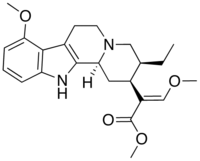- Mitragynine
-
Mitragynine  (E)-2-[(2S,3S)-3-ethyl-8-methoxy-1,2,3,4,6,7,12,12b- octahydroindolo[3,2-h]quinolizin-2-yl]-3- methoxyprop-2-enoic acid methyl ester
(E)-2-[(2S,3S)-3-ethyl-8-methoxy-1,2,3,4,6,7,12,12b- octahydroindolo[3,2-h]quinolizin-2-yl]-3- methoxyprop-2-enoic acid methyl esterIdentifiers CAS number 6202-22-8 PubChem 3034396 ChemSpider 2298865 
Jmol-3D images Image 1 - O=C(OC)\C(=C\OC)[C@H]4C[C@H]3c2nc1cccc(OC)c1c2CCN3C[C@H]4CC
- InChI=1S/C23H30N2O4/c1-5-14-12-25-10-9-15-21-18(7-6-8-20(21)28-3)24-22(15)19(25)11-16(14)17(13-27-2)23(26)29-4/h6-8,13-14,16,19,24H,5,9-12H2,1-4H3/b17-13+/t14-,16+,19+/m1/s1

Key: LELBFTMXCIIKKX-QVRQZEMUSA-N
InChI=1/C23H30N2O4/c1-5-14-12-25-10-9-15-21-18(7-6-8-20(21)28-3)24-22(15)19(25)11-16(14)17(13-27-2)23(26)29-4/h6-8,13-14,16,19,24H,5,9-12H2,1-4H3/b17-13+/t14-,16+,19+/m1/s1
Key: LELBFTMXCIIKKX-QVRQZEMUBK
Properties Molecular formula C23H30N2O4 Molar mass 398.4953  (verify) (what is:
(verify) (what is:  /
/ ?)
?)
Except where noted otherwise, data are given for materials in their standard state (at 25 °C, 100 kPa)Infobox references Mitragynine, an indole alkaloid, is the most abundant active alkaloid in the plant Mitragyna speciosa, commonly known as Kratom.[1]
Contents
Pharmacology
In small doses its activity is reported to be stimulant-like, while in higher doses more opiate-like. These effects agree with the profile of mitragynine's actions developed by study of its action on the brain. It has been shown to be adrenergic (like some related alkaloids from yohimbe) at lower doses, while at higher doses mitragynine acts on the mu- and delta-opiate receptors. The mu-opiate receptors are responsible for the enjoyable effects of the opiates, analgesia, and physical dependence. Its potential for treating drug addiction, perhaps in combination with ibogaine, is being investigated[who?]. It is orally active.
Mitragynine itself acts primarily via μ-opioid receptors, although its oxidation product mitragynine-pseudoindoxyl, which is likely to be a major component of kratom that has been aged or stored for extended periods, acts as a fairly selective δ-opioid agonist with little affinity for μ or κ receptors.[2] Another alkaloid with a major contribution to the μ-opioid activity of the kratom plant is the related compound 7-hydroxymitragynine, which while present in the plant in much smaller quantities than mitragynine, is a much more potent μ-opioid agonist.[3]
Discovery
Mitragynine was isolated in 1907 by D. Hooper, a process repeated in 1921 by E. Field who gave the alkaloid its name. Its structure was first fully determined in 1964 by D. Zacharias, R. Rosenstein and E. Jeffrey.
Structure
It is structurally related to both the yohimbe alkaloids and, more distantly, voacangine. Chemically, mitragynine is 9-methoxy-corynantheidine.
Dose
Dry kratom leaf contains roughly 0.25% mitragynine. A typical dose ranges from 15 mg to 65 mg.
Synthesis
The first total synthesis of mitragynine was reported by Takayama et al. in 1995.[4]
Chemical properties
Physically the freebase is a white, amorphous powder. It is soluble in alcohol, chloroform and acetic acid.
References
- ^ Jansen KL, Prast CJ (1988). "Ethnopharmacology of kratom and the Mitragyna alkaloids". J Ethnopharmacol 23 (1): 115–9. doi:10.1016/0378-8741(88)90121-3. PMID 3419199.
- ^ Takayama H, Ishikawa H, Kurihara M, Kitajima M, Aimi N, Ponglux D, Koyama F, Matsumoto K, Moriyama T, Yamamoto LT, Watanabe K, Murayama T, Horie S (April 2002). "Studies on the synthesis and opioid agonistic activities of mitragynine-related indole alkaloids: discovery of opioid agonists structurally different from other opioid ligands". J. Med. Chem. 45 (9): 1949–56. doi:10.1021/jm010576e. PMID 11960505.
- ^ Takayama H (August 2004). "Chemistry and pharmacology of analgesic indole alkaloids from the rubiaceous plant, Mitragyna speciosa". Chem. Pharm. Bull. 52 (8): 916–28. doi:10.1248/cpb.52.916. PMID 15304982. http://www.ncbi.nlm.nih.gov/pubmed/15304982.
- ^ Takayama H.; Maeda M.; Ohbayashi S.; Kitajima M.; Sakai S.-i.; Aimi N. (1995). "The First Total Synthesis of (-)-Mitragynine, An Analgesic Indole Alkaloid in Mitragyna speciosa". Tetrahedron Letters 36 (51): 9337–9340. doi:10.1016/0040-4039(95)02022-H.
See also
- 7-hydroxymitragynine
- Mitragynine pseudoindoxyl
- Mitraphylline
- Kratom
Categories:- Opiates
- Indole alkaloids
- Indoloquinolizines
- Ethers
- Delta-opioid agonists
Wikimedia Foundation. 2010.
